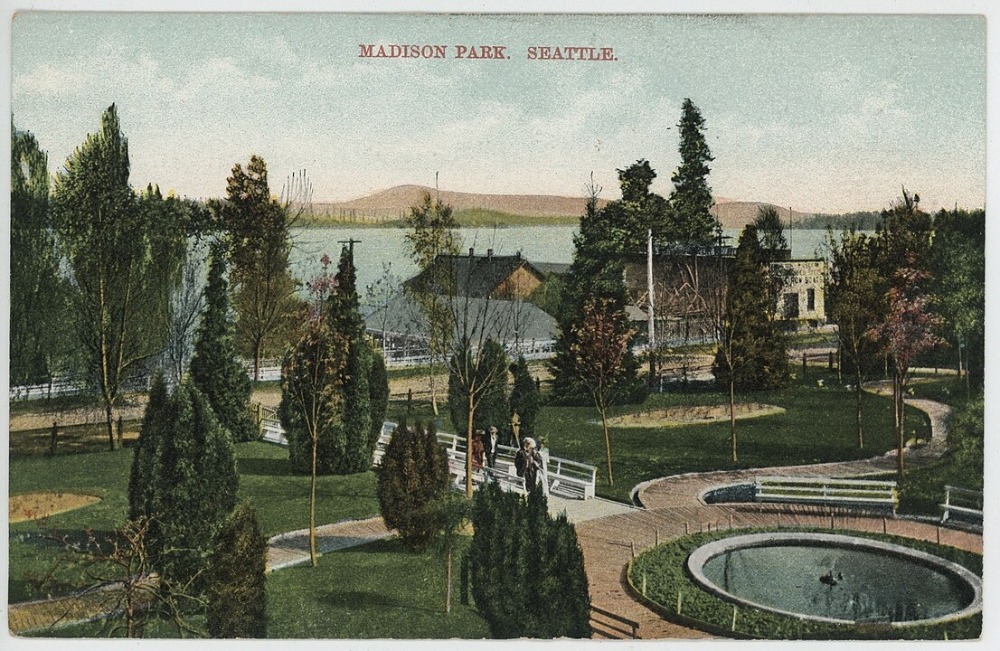Seattle has many fine parks — never enough, but many. One of the best is the verdant gem called Madison Park, once an ancient Native fishing and trading camp, and once a park with baseball grandstand.
Former New Yorker Judge John J. McGilvra once practiced law in association with Abraham Lincoln. When Lincoln became president of the United States, he appointed McGilvra U.S. Attorney for the new Washington Territory. Nearby McGilvra Elemenary School attests to this founder.
McGilvra began investing in Puget Sound real estate, including 320 acres on the western shore of Lake Washington. To reach his new claim he cut a straight-line, diagonal road to and from downtown Seattle, Madison Street, which today is the city’s only direct vehicle route between salt and fresh water.
A kind of stage-coach first negotiated McGilvra’s rutted path. Later, an electric trolley car took picknickers to Lake Washington and McGilvra’s claim. The judge platted most of his property for sale and added the interesting clause that only “cottages” could be built on his lots.
The 1890 Seattle City Directory called this area “Madison Street Pavilion,” although the 21 acres McGilvra set aside for public use were popularly referred to as “Madison Park.” During 1892-1900 a baseball park and wooden grandstand existed just north of Madison Street near the lake, home for the first Northwest professional baseball champs.
My father recalled going to Madison Park from Capitol Hill as a boy with his pals, spending several days camping on wooden platforms built on the shore. In 1898 George Cotterill’s 25-mile bicycle path included busy Madison Park.
Judge McGilvra seemed to welcome company near his lakeside retreat — as well as selling lots — because he launched an impressive waterfront development: boathouse, piers, a wooden promenade, twin bandstands offshore with shoreline seating for what was described as a “thousand” spectators. Beer was sold to audiences listening to Wagner’s Band and Gilbert and Sullivan operettas. The lake’s Mosquito Fleet made Madison Park a regular stop, and visitors were encouraged to go by boat from the park to Webster Point, in today’s Laurelhurst neighborhood.
Perhaps the Madison Park cable car was Seattle’s most successful rail route. In summer, cars ran every two minutes. In winter, glass panels were installed to protect passenger and motormen from Seattle rains. Freight cars were sometimes pulled and advertising on the sides of cars became popular diversions.
In 1902-03 the popular Olmsted Brothers of Boston were hired by the city to develop a Seattle park system. Madison Park was by-passed by the consultants, possibly because the park had few park-like amenities and more closely resembled a Tivoli amusement area with a busy cable-car terminal.
The opening of the 1917 ship canal in Montlake, connecting Lakes Union and Washington, caused a 9-foot drop in the water level. A new shoreline was the result, and it soon appeared around receding Lake Washington. Two years later a Madison Park bathhouse was built, and in 1922 the shore area, bathhouse and all, was transferred to the Seattle Parks Department. From this point the quiet, glen-like waterfront playground and shopping strip began to resemble the prime residential Madison Park as we know it today.
Discover more from Post Alley
Subscribe to get the latest posts sent to your email.

Great history!
Having grown up in Madison Park, I thoroughly enjoyed this. I wonder if the “cottages” covenant is still in place?
Thank you, Junius.
This story makes me consider driving I-5 to visit the park again.